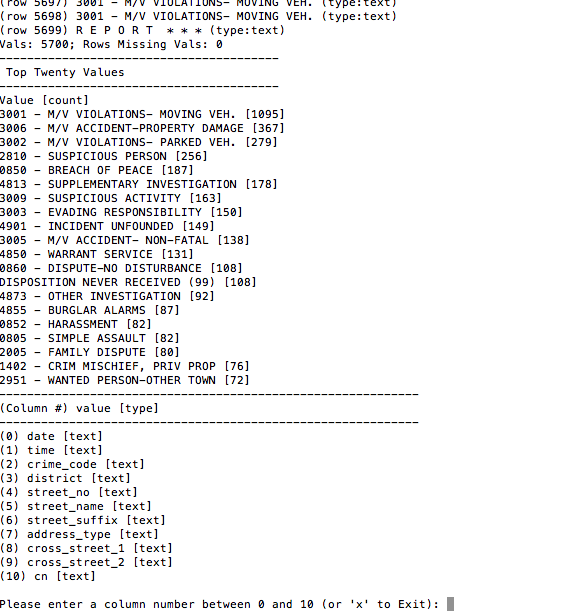Every 6-8 months, when I need to use the python xlrd library, I end up re-finding this page:
In this case, I’ve finally bookmarked it:)
from __future__ import print_function
from os.path import join, dirname, abspath
import xlrd
fname = join(dirname(dirname(abspath(__file__))), 'test_data', 'Cad Data Mar 2014.xlsx')
# Open the workbook
xl_workbook = xlrd.open_workbook(fname)
# List sheet names, and pull a sheet by name
#
sheet_names = xl_workbook.sheet_names()
print('Sheet Names', sheet_names)
xl_sheet = xl_workbook.sheet_by_name(sheet_names[0])
# Or grab the first sheet by index
# (sheets are zero-indexed)
#
xl_sheet = xl_workbook.sheet_by_index(0)
print ('Sheet name: %s' % xl_sheet.name)
# Pull the first row by index
# (rows/columns are also zero-indexed)
#
row = xl_sheet.row(0) # 1st row
# Print 1st row values and types
#
from xlrd.sheet import ctype_text
print('(Column #) type:value')
for idx, cell_obj in enumerate(row):
cell_type_str = ctype_text.get(cell_obj.ctype, 'unknown type')
print('(%s) %s %s' % (idx, cell_type_str, cell_obj.value))
# Print all values, iterating through rows and columns
#
num_cols = xl_sheet.ncols # Number of columns
for row_idx in range(0, xl_sheet.nrows): # Iterate through rows
print ('-'*40)
print ('Row: %s' % row_idx) # Print row number
for col_idx in range(0, num_cols): # Iterate through columns
cell_obj = xl_sheet.cell(row_idx, col_idx) # Get cell object by row, col
print ('Column: [%s] cell_obj: [%s]' % (col_idx, cell_obj))
Interact and pull data from a selected column. (This could be done with 1/5 of the code in pandas, etc.)

Code example
from __future__ import print_function
from os.path import join, dirname, abspath, isfile
from collections import Counter
import xlrd
from xlrd.sheet import ctype_text
def get_excel_sheet_object(fname, idx=0):
if not isfile(fname):
print ('File doesn't exist: ', fname)
# Open the workbook and 1st sheet
xl_workbook = xlrd.open_workbook(fname)
xl_sheet = xl_workbook.sheet_by_index(0)
print (40 * '-' + 'nRetrieved worksheet: %s' % xl_sheet.name)
return xl_sheet
def show_column_names(xl_sheet):
row = xl_sheet.row(0) # 1st row
print(60*'-' + 'n(Column #) value [type]n' + 60*'-')
for idx, cell_obj in enumerate(row):
cell_type_str = ctype_text.get(cell_obj.ctype, 'unknown type')
print('(%s) %s [%s]' % (idx, cell_obj.value, cell_type_str, ))
def get_column_stats(xl_sheet, col_idx):
"""
:param xl_sheet: Sheet object from Excel Workbook, extracted using xlrd
:param col_idx: zero-indexed int indicating a column in the Excel workbook
"""
if xl_sheet is None:
print ('xl_sheet is None')
return
if not col_idx.isdigit():
print ('Please enter a valid column number (0-%d)' % (xl_sheet.ncols-1))
return
col_idx = int(col_idx)
if col_idx < 0 or col_idx >= xl_sheet.ncols:
print ('Please enter a valid column number (0-%d)' % (xl_sheet.ncols-1))
return
# Iterate through rows, and print out the column values
row_vals = []
for row_idx in range(0, xl_sheet.nrows):
cell_obj = xl_sheet.cell(row_idx, col_idx)
cell_type_str = ctype_text.get(cell_obj.ctype, 'unknown type')
print ('(row %s) %s (type:%s)' % (row_idx, cell_obj.value, cell_type_str))
row_vals.append(cell_obj.value)
# Retrieve non-empty rows
nonempty_row_vals = [x for x in row_vals if x]
num_rows_missing_vals = xl_sheet.nrows - len(nonempty_row_vals)
print ('Vals: %d; Rows Missing Vals: %d' % (len(nonempty_row_vals), num_rows_missing_vals))
# Count occurrences of values
counts = Counter(nonempty_row_vals)
# Display value counts
print ('-'*40 + 'n', 'Top Twenty Values', 'n' + '-'*40 )
print ('Value [count]')
for val, cnt in counts.most_common(20):
print ('%s [%s]' % (val, cnt))
def column_picker(xl_sheet):
try:
input = raw_input
except NameError:
pass
while True:
show_column_names(xl_sheet)
col_idx = input("nPlease enter a column number between 0 and %d (or 'x' to Exit): " % (xl_sheet.ncols-1))
if col_idx == 'x':
break
get_column_stats(xl_sheet, col_idx)
if __name__=='__main__':
excel_crime_data = join(dirname(dirname(abspath(__file__))), 'test_data', 'Cad Data Mar 2014.xlsx')
xl_sheet = get_excel_sheet_object(excel_crime_data)
column_picker(xl_sheet)